Let us continue our long, NamCompendium nightmare that is the documentation of Ms. Pac-Man's ports. This "not really a Namco game but they sorta repatriated it kinda into canon" game started its life as (probably) a joint Namco-General Computer Corporation-Midway joint before being licensed to Atari, Incorporated, who then dragged GCC into developing versions of Ms. Pac-Man for Atari platforms while Atari was divided into two separate companies, both of which would continue to do things with Ms. Pac-Man and one of which would eventually feature a former Namco VP as its President. Got all that? Good. It gets better from here.
Alright so, there's two motherfucking versions of Ms. Pac-Man on the NES.
Let's just rip this bandaid right the hell off. The first of these two misfit releases comes to us courtesy of everybody's favorite Atari Games subsidiary, Tengen. We have previously encountered Tengen in our Pac-Man coverage, wherein they had entered into a protracted legal dispute with Nintendo over their unlicensed cartridges and unsanctioned Tetris release. Atari Games had a standing arrangement to act as the publisher of Namco titles for the NES in North America prior to the opening of a Namco office on the continent. Thus, at some indeterminate point in 1990, a subsidiary of a third party publisher developed and released an unlicensed version of a separate third party's game. Hooray!
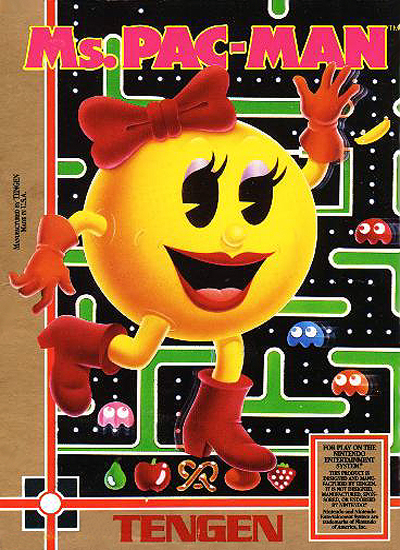
And here's the kicker: it's really good! It nails the fundamentals of the arcade game by replicating the maze layouts, colors, and even the behaviors of the ghosts (insofar as I can tell, I'm no Pac-Man ghost AI expert) on NES hardware. Ms. Pac-Man moves nice and fast with the default settings, leading to the same breakneck gameplay clip that GCC managed to release in 1982. The sounds are not arcade accurate, but are close facsimiles and manage to at least be on key with the original item. The worst thing that may be said about the core gameplay is there is a scrolling solution implemented here, which enabled the programmers at Tengen to preserve the integrity of the original maze designs. Yet even here I can't complain, as you are able to see about 60 percent of the maze at any given time and the ghosts are generally in the same half as you. It's not ideal, but compared to the tiny postage stamp scrolling windows of other Pac-Man ports this is a dream.
Not content to simply make a great port of the base game, Tengen went several extra miles here. Also included are three different options for two players: simultaneous cooperative and competitive modes, plus an asynchronous mode. You also get a Turbo mode option, which you can set to be either toggle-able or on at all times, plus the ability to select your starting maze, PLUS a selection of three more varieties of mazes. It's a really impressive amount of gameplay they manage to get out of a nearly decade old arcade title, and likely makes this one of the best non-licensed NES games available. Full kudos to the team of Franz Lanzinger (programming), Dave O'Riva (audio), and Jeff Yonan (special thanks), a team also responsible for perennial Giant Bomb favorite Toobin' on the NES.
Atari Games proceeded to license out the development of the next few releases of Ms. Pac-Man, which landed on Sega's home consoles.
The first of these was the July 1991 release of Ms. Pac-Man for the Genesis in North America. It begins with one of the single worst splash screens I have had the displeasure of viewing:
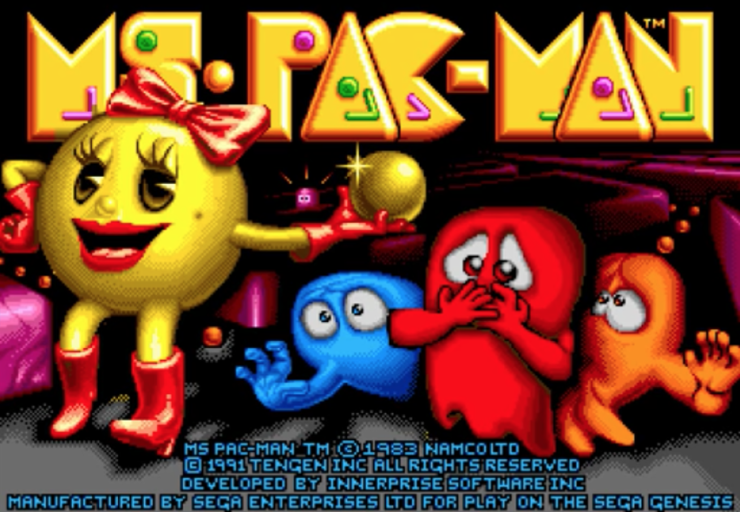
I mean, even one of the ghosts depicted here is about to vomit all over this thing. It gives off an overpowering vibe of cheapness, with its dithered shading and off-brand depiction of established "characters" in the game's universe. Even the game title font looks garish and wrong here. Abysmal stuff.
Then you start playing, and things get quite a bit better. This is basically a 16-bit touch up job on Tengen's NES iteration of Ms. Pac-Man, handled by Maryland-based Innerprise Software. Innerprise were big Motorola X68000 fans, with the bulk of their output being Amiga games. This was one of three games developed by Innerprise for the Genesis, with another having recently been covered by Giant Bomb's own @mento right over here. Once you excise the splash screen, the backgrounds added to the attract mode, and some brash color choices in the mazes, this is in fact an a slavish recreation of the NES game. The ghosts and maze walls now have an odd candy apple sheen to them, an aesthetic decision I don't enjoy. But if you've ever wanted to play what amounts to a 16-bit remaster of an 8-bit game that doesn't include "Mario" in the title, this has all of the bells and whistles the progenitor had. Just bust out an arcade stick.
Next up on deck was the Europe-exclusive release of Ms. Pac-Man for the Master System in December 1991. This port is yet again a recreation of the Tengen game for a new platform. All of the features of the NES game are here, which is great, but this is otherwise a rough game. The Master System has a larger color palette than the Famicom/NES, which gives some of the titles in its library a bit of a visual edge over their 8-bit console contemporaries. This is a case of a bad use of that additional color depth. Ms. Pac-Man now boasts a gross looking lipstick ring around her wedge mouth (I will accept my Pulitzer Prize for this sentence now, thank you) and the developers have really done a number on the ghosts. Gone are the simple upside down "U" shapes, replaced with some sort of bell as a silhouette and a waxy looking attempt at shading applied to each of them. The sound of this port also suffers quite a bit, even held against the likes of the 5200 release. It was an inauspicious beginning for "Namco" games on the Master System/Mark III; we've had a glance at this system previously for the unsanctioned (and apparently Korean) King & Balloon port it received. This was one of only two official Namco games for the system, and the final one won't be covered for a while.
(Fun aside: There's a developer note left in the game code. Unlike Super Monkey Daibouken's lewd personal ad note, this one's a much humbler request: "Tel da' DJ ta put da BRASS DISC ON!!!" The Cutting Room Floor suggests this is the opening line to some wonderfully trashy house music.)
For two years the Ms. Pac-Man guns fell silent. In the interim, several things had happened on a very exciting business level. The Atari-Nintendo lawsuit had ended, and Namco had established a North American publishing arm with Namco Hometek in California. It was only at this point that Namco as a company decided, as I would frame it, to repatriate Ms. Pac-Man from its decidedly third party origins into the Namco portfolio.
The first fruits of this repatriation were Namco-developed ports of Ms. Pac-Man for the Game Gear and Game Boy. The former can only be narrowed down as far as a 1993 release year. While it wouldn't surprise me to learn that this shares some DNA with Namco's 1991 Pac-Man port to the Game Gear, there are a few changes here. The ghost sprites have been redrawn, replacing Pac-Man GG's squat outlines with silhouettes that more closely conform with the arcade original antagonists. The sound effects have been tweaked here, but in my humble opinion they have less of a "hectic arcade" palette and more of a "this just sounds gross" flavor to them. The strangest touch is the maze walls, which have been redrawn to given them bizarre drop shadows to simulate some sort of off-screen light source that affects no other elements of the game. It doesn't look great. Namco also took the liberty of adding some new mazes, tweeking the order in which mazes rotate, and adding a new cutscene of another Junior Pac-Man. These changes aren't particularly welcome, in my estimation. Stick with OG Pac-Man on the Game Gear, and also don't buy a Game Gear in 2018.
The latter, released in October 1993, features the same no good, very bad hamartia of Namco's Game Boy port of Pac-Man: a Damoclesian choice between playing Ms. Pac-Man in a one inch tall maze with ants for sprites, or with maybe 40% of the play field visible at any time with horizontal and vertical scrolling. Both are desperate solutions, especially considering Namco had already utilized Tengen's more thoughtful alternative on the Game Gear ports. The game play is also notably slower here, and the loss of color makes any sort of quick reading of ghost AI all but impossible. These solutions to porting arcade Pac-Man to a monochrome handheld were drastic enough on that simpler game, but here they sting that much more.
Then, as alluded to above, we arrive at the second and entirely new version of Ms. Pac-Man for the Nintendo Entertainment System. This time, the game was a fully sanctioned and licensed release on the platform with the Seal of Quality and development duties handled by Now Production, of Adventure Island IV (and Game Boy Dig Dug) fame. And... it isn't great.
If we travel back in time to Namco's own 1984 port of Pac-Man for the Famicom (subsequently released three times for the NES) you'll find what was at the time the closest thing to an arcade accurate conversion of the game. Subtract a few dots, down pitch the music, but retain the arcade's portrait maze orientation and most of the speed. That release is very much the template for this port, which came exclusively to North American shelves in November 1993. Namco added some features to the base game; borrowing from their Game Gear port, they built new mazes and the fiddled with the order in which they appear. There's even an additional cutscene with yet another Junior Pac-Man. Yet these added features cannot salvage this port.
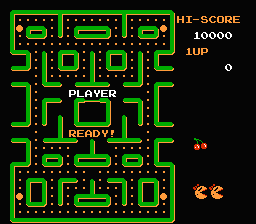
By this point Namco had been developing games for the Super Famicom/SNES for two years, and this may play into why this release feels so fobbed off. It is an absolutely bare bones rendition of Ms. Pac-Man. No attract screen. No simultaneous two player modes. Just the same basic layout as a nine year old game from the earliest years of the Famicom, given a frankly hideous color palette and some mazes of dubious merit. But what really does this in is how damn difficult it feels. The Famicom port of Pac-Man takes its time, waiting about half a minute for all of the ghosts to enter the maze. Here all of the ghosts have jumped into the pool in about eight seconds, and even quicker on the optional "Hard" difficulty (the only option you have outside asynchronous multiplayer). When you couple in the more aggressive ghosts and their rapid deployment with a smaller maze and a movement speed that feels on par with that of NES Pac-Man, versus the brisk pace of the arcade original, you wind up with some very short times to death. Taken as a whole, it's a little nuts that Namco did not simply secure an official license to distribute the Tengen game with Nintendo's blessing. This would be their swan song outing on the NES, and it feels like an absolute whimper.*
So where's our next stop on this endless nightmare train? Surely another 16-bit console? Maybe we'll step into the PlayStation timeline? Nope. Our next port of call, if you can believe it, is with Philips. The mother lovin' CD-i. Strap yourselves in for this shit.
I've talked a lot about the Namco Museum franchise on here, and with good reason. They were a very early instance of a video game company becoming very self reflexive and celebrating their back catalog by putting them into mass market circulation. Arcade Classics, released only in Europe at some point in 1995, feels like a pilot release for this ongoing series of compilations. Here we have remakes of Galaxian, Galaga, and Ms. Pac-Man on a single disk. Like the PlayStation series of Namco Museum titles, the games here are actually ports as opposed to dumps of games. Unlike the Museum releases, however, these are all a bit unique. Galaxian looks and feels like a slightly touched up conversion of the Famicom conversion, which at this point was over a decade old. Galaga, as best I can tell, is the Famicom conversion running in a window, with score data to the right, and with a nearly arcade perfect rip of the original audio layered over it. And then there's the Ms. Pac-Man conversion, which is just really fucking weird.
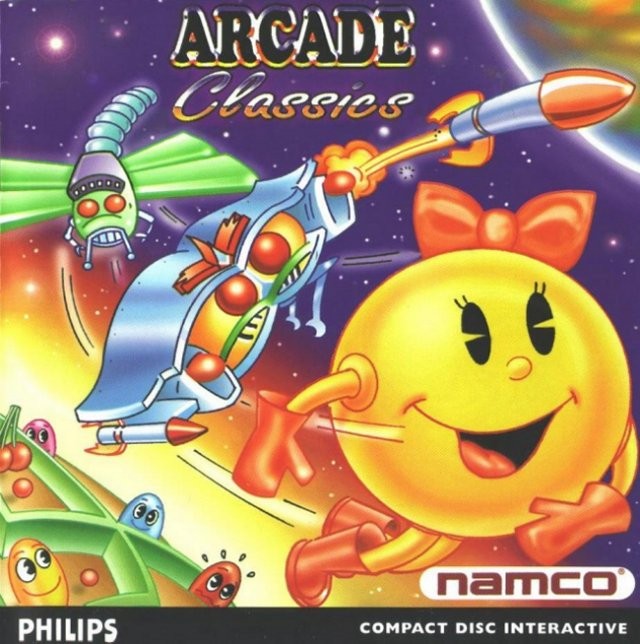
This iteration of Ms. Pac-Man very clearly takes the Tengen game as its starting point, which means what we have here is a vertical scrolling solution for the maze. The maze color selections and sprites are different from other 16-bit versions of the game, however, and the look and feel of this port makes it clear this wasn't just a ROM dump. That may be for the worse though, as based on what I can find about the title online (I won't pretend to have played any PAL exclusive CD-i games) this version of Ms. Pac-Man suffers from a bad scrolling implementation that lags behind the player's position in the maze. I've also found a few sources (including the one above) which cite input delay as an issue in this conversion. Suffice to say, aside from already being on the CD-i, this conversion specifically is well worth avoiding.
Stepping back into the safe harbor of non-Philips video game hardware, Ms. Pac-Man's next home console release was on the Super Nintendo in September 1996. This one represents a sort of last huzzah for the Tengen template of the game, but this time with Digital Eclipse handling development and Williams handling the publishing in North America. It uses the same awful splash screen as the Mega Drive port, only redrawn for the SNES resolution and color space, and also features that version's distinctive candy coated sheen across maze walls and sprites. Otherwise, it's the same feature set as the Tengen NES port but on faster hardware and with music that is practically identical to the arcade. Every time I have to confess a SNES game sounds better than the Genesis counterpart my soul cries out in anguish, but the difference in audio really pushes this conversion up to the top of the list. It may have been more impressive on the NES, but this is so far the best Ms. Pac-Man covered in the NamCompendium.
The final standalone release on a cartridge for this was Ms. Pac-Man: Special Color Edition for the Game Boy Color. If you've seen my Pac-Man coverage, you know precisely what this is: the Game Boy version of Ms. Pac-Man, but remade with color. Same scrolling solutions, same game speed, basically everything that weighs down the monochrome ports of these games, but now with glorious color for your non-backlit displays. The funny thing about this cartridge specifically is that it was in fact a compilation which also included Super Pac-Man, Namco's own internally developed sequel to Pac-Man which simultaneously feels like a response to, and is thunderously worse than, the externally developed Ms. Pac-Man. Bundled together out of spite, or perhaps as a sort of "Hey, we also made a sequel to one of the most important video games of all time"? Hard to say.
Before we enter into the long, long list of Ms. Pac-Man compilation games that followed on from the Namco Museum's launch in late 1995, there was one more release I'd like to mention. Like the CD-i port, it's a real freak that only appeared in one territory and one I also have not played. Did you know, dear readers, that Ms. Pac-Man was the launch game for a service called Xbox Live?
The original Xbox Live kit came with a bundled disk featuring some truly amazing mid-2000s gamer speak tutorials on how to set up your Xbox for online play, some links (now forever broken with the closure of original Xbox Live being offline for about eight years at time of writing), and what looks to be a dump of the PlayStation port of Ms. Pac-Man included in Namco Museum Volume 3. The tell is the damn borders. You would have been able to upload scores to online leaderboards with this version, and it would be interesting to see what sort of score battles were happening on this now defunct online platform prior to its closure. Still, if you can get your hands on the Xbox Live Arcade disk from this crusty old starter pack, you've got a way to play a standalone Ms. Pac-Man and damn it, that's the sort of trivia NamCompendium is all about.
Finally, a long list of compilations. This is already a lengthy little piece of writing, so I'm going to really fly through these unless there's anything worth noting.
- Namco Museum Volume 3 (21 Jun 1996, PS1)
- Given most of the ports covered so far have been North American and European releases, this might have been the first readily playable version of Ms. Pac-Man widely available in Japan.
- Namco Museum 64 (N64, 1999)
- Namco Museum (DC, 20005; GBA 2001, PS2 2001, XBOX and GCN 2002)
- Namco Museum (PSP, 2005 [JP]])
- Namco Museum Battle Collection (PSP, 2005 [NA])
- Namco Museum 50th Anniversary (PS2, XBOX, GCN, GBA, 2005)
Ms. Pac-Man has also made appearances on Sony and Microsoft digital store fronts. It first arrived on Xbox Live on 9 January 2007, and on PSN it was a free add-on for Pac-Man Museum until late 2014, at which point it became $4.99 piece of DLC. Ms. Pac-Man was simultaneously released on 20 April 2016 for the PS4 and XBO as a digital download for $3.99.
Curiously absent from the above list are Nintendo platforms from after 2001. Ms. Pac-Man made no appearances on the DS, 3DS, Wii, or Wii U, and has yet to show up on the Switch.
Finally, there is the matter of arcade compilations. A far more straightforward release was Pac-Man's Arcade Party, a 2010 arcade release that compiled 13 Namco titles into a single cabinet with an LCD display. If you like your arcade games lacking the glow of a CRT, I'm sure this is fine.
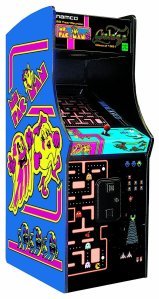
It is the arcade compilation prior to Pac-Man's Arcade Party that is of particular note for the NamCompendium. The fantastic "Ms. Pac-Man/Galaga - Class of 1981" arcade cabinet, released in December 2000, included a slightly modified release of the original Ms. Pac-Man. As it turns out, the licensing terms that had eventually been arrived at by the three concerned parties in the early 1980s (GCC, Midway, and Namco) had not allowed for this sort of release. So, Doug Macrae and the co-developers of Ms. Pac-Man went to Namco's American offices and it was determined that, insofar as Namco was concerned, Namco had internally developed Ms. Pac-Man in the first place. The entire sordid history had been forgotten. And so seven years of arbitration began, during which time Ms. Pac-Man entered into the messy world of digital distribution and the rights situation became increasingly complicated. Eventually a settlement was reached between Namco and GCC to cover future distribution, the terms of which are not public. If any of this interests you in the slightest, I would strongly encourage you to read Fast Company's article from last year which includes interviews with GCC staff and goes into great detail over the rights to this fantastic game.
Ms. Pac-Man's origins and release history are an absolute mess. This is surely, surely the most into the weeds the NamCompendium will ever be, hunting down the Namco-sanctioned publication of a third-party developed port of a third-party developed sequel developed with only a vague nod to the original work it ultimately surpassed. It would be nice to transition back into actual Namco titles without all of this baggage. However, as we've already dived thirty feet into the deep end of this pool, I figure we might as well touch the bottom of it. The next entry into the NamCompendium will be the first (and perhaps final?) NamCompendium Gaiden entry, wherein we shall briefly examine the rest of Midway's Pac-Man spinoffs. You know, the ones that were decidedly not improvements on the original.
* As mentioned, Ms. Pac-Man was a North America exclusive. The Famicom never received a Ms. Pac-Man port, but it did receive its final Namco game one month later in December 1993. It may surprise you to learn that the final Namco game on Nintendo's first home console was yet another Famista title.

Log in to comment